
Plants chickens like to eat
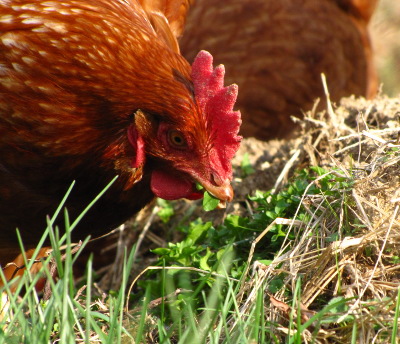 What
do chickens eat on pasture? Invertebrates are their favorites,
but I'm still working out methods of attracting tasty insects and worms
for the flock to consume. (Keeping a compost pile in each pasture
is a good start.) Meanwhile, I did some research and then kept
notes on the plants our chickens enjoyed.
What
do chickens eat on pasture? Invertebrates are their favorites,
but I'm still working out methods of attracting tasty insects and worms
for the flock to consume. (Keeping a compost pile in each pasture
is a good start.) Meanwhile, I did some research and then kept
notes on the plants our chickens enjoyed.
Traditional
chicken pastures
tend to be either unimproved pastures (ie whatever survives repeated
close grazing), or mixtures of legumes (white clover and subclovers),
grasses (orchardgrass, perennial
ryegrass, tall
fescue, and annual ryegrass), and weeds. Some  farmers plant annuals like
oats or rye in certain plots for winter forage.
farmers plant annuals like
oats or rye in certain plots for winter forage.
Our pastures are
currently a mix of native woodland and whatever popped up when we mowed
other reclaimed woods for a few years. That gave me a chance to
watch our chickens explore quite a range of habitats, and I
discovered that they showed seasonal preferences for plant foods.
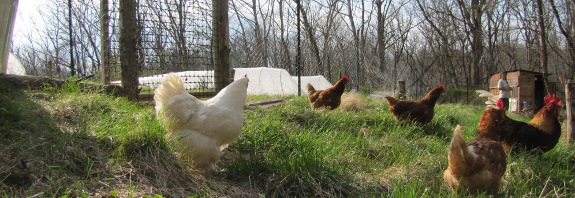
 In the winter and early
spring, most plants are dormant, but our flock still found some tasty
wild food. Ground
cherry fruits
hung on the plants until February and were thoroughly enjoyed, even
though the chickens had to find a way through the papery husks. Chickweed leaves,
of course, were a huge hit --- whenever we turned chickens into
fresh pasture in early spring, they ran straight to the chickweed
before eating anything else. The chickens were willing to eat tender
young grass leaves,
but only after all of the tastier
In the winter and early
spring, most plants are dormant, but our flock still found some tasty
wild food. Ground
cherry fruits
hung on the plants until February and were thoroughly enjoyed, even
though the chickens had to find a way through the papery husks. Chickweed leaves,
of course, were a huge hit --- whenever we turned chickens into
fresh pasture in early spring, they ran straight to the chickweed
before eating anything else. The chickens were willing to eat tender
young grass leaves,
but only after all of the tastier  plants were gone.
plants were gone.
As spring advanced, our
chickens started chowing down on clover and fleabane
leaves.
Although I'd read that most people plant white clover in their chicken
pastures, red clover
seemed to be
preferred by our flock. Our rooster fell in love with violet
flowers, but no
one else seemed interested.
Chickweed was past its prime
in mid April (at least according to our snobbish chickens), so they
turned to small-flowered crowfoot seeds.
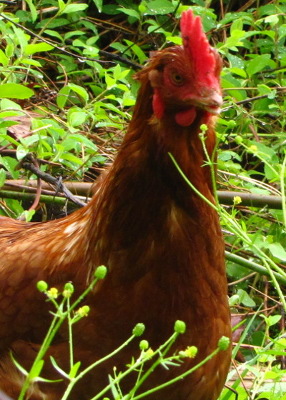 Chickweed was still their second favorite food, though, and they also
enjoyed other tender young plants for the rest of the spring period.
Chickweed was still their second favorite food, though, and they also
enjoyed other tender young plants for the rest of the spring period.
Come late May, the pastures were changing --- the "weeds" were starting
to get too woody for chicken digestion and the grasses were going to
seed. Now the flock enjoyed a smorgasbord of grass seed heads, sedge seed heads, cranesbill seeds, clover leaves, and
violet leaves.
And then we hit the summer lull. Drier weather slowed down the
tender new growth chickens crave, big weeds shaded the ground, and
suddenly grass leaves were a favorite because they were the only
non-lignified plants within reach. Our one patch of warm
season grass
was especially hard hit since it kept producing throughout the
summer. In contrast to our traditional pastures, the forested
pasture became a virtual desert from a chicken's point of view.
In late August, Mark fenced in a new forest pasture. In this
previously fallow land, there was still fresh growth on the forest
floor, and our flock enjoyed Japanese
stiltgrass leaves and various seed heads...for two days.
Then they asked to go back to the perennial grasses.

As a side note, I should mention the
foods preferred by our chicks, since they were quite different
than those consumed by adult chickens. Chicks have tiny beaks, so
they can't eat 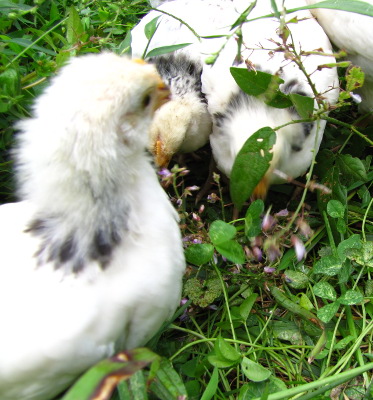 anything
large and they can't break anything tough up into bits small enough to
eat (without a hen's help.) Our spring batch ate everything in
sight since the greenery was all so succulent, but our fall chicks had
more trouble finding tasty food they could actually eat. Tick
trefoil flowers and sourgrass
flowers and young seed pods fit the bill even at the beginning
of September, and then the chicks branched out into eating sourgrass leaves and clover leaves
as they got a bit older.
anything
large and they can't break anything tough up into bits small enough to
eat (without a hen's help.) Our spring batch ate everything in
sight since the greenery was all so succulent, but our fall chicks had
more trouble finding tasty food they could actually eat. Tick
trefoil flowers and sourgrass
flowers and young seed pods fit the bill even at the beginning
of September, and then the chicks branched out into eating sourgrass leaves and clover leaves
as they got a bit older.
Finally, I should mention that I tried out planting various annuals in
the pastures throughout the year. In the long run, I've decided
that planting annuals only makes sense to give the chickens fresh food
during the summer and winter lulls --- otherwise, leaving the planted
ground chicken-free for a few weeks or months as the cultivated crops
get established just slows down rotation speeds and does the pastures
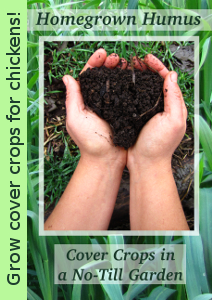 more harm than good. And it turns out that our flock only really
enjoyed one cultivated plant I tried --- butternut squash.
The vines were able to survive moderate chicken scratching, and the
fruits were happily hollowed out by our hungry chickens.
more harm than good. And it turns out that our flock only really
enjoyed one cultivated plant I tried --- butternut squash.
The vines were able to survive moderate chicken scratching, and the
fruits were happily hollowed out by our hungry chickens.
I went into the year thinking that I'd see what our chickens' favorite
foods were and then plant pastures in just those plants. However,
as the year progressed, I started to realize that I need to think of
the pasture as an ecosystem rather than as a collection of
plants. Next year, I'll be experimenting with traditional pasture plants along with perennials that provide off-season feasts.
This post is part of our 2011 Chicken Experiments lunchtime series.
Read all of the entries:
|
Want more in-depth information? Browse through our books.
Or explore more posts by date or by subject.
About us: Anna Hess and Mark Hamilton spent over a decade living self-sufficiently in the mountains of Virginia before moving north to start over from scratch in the foothills of Ohio. They've experimented with permaculture, no-till gardening, trailersteading, home-based microbusinesses and much more, writing about their adventures in both blogs and books.
Want to be notified when new comments are posted on this page? Click on the RSS button after you add a comment to subscribe to the comment feed, or simply check the box beside "email replies to me" while writing your comment.
- Remove comment
- Remove comment
